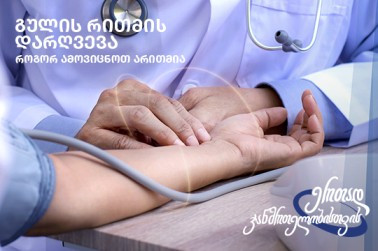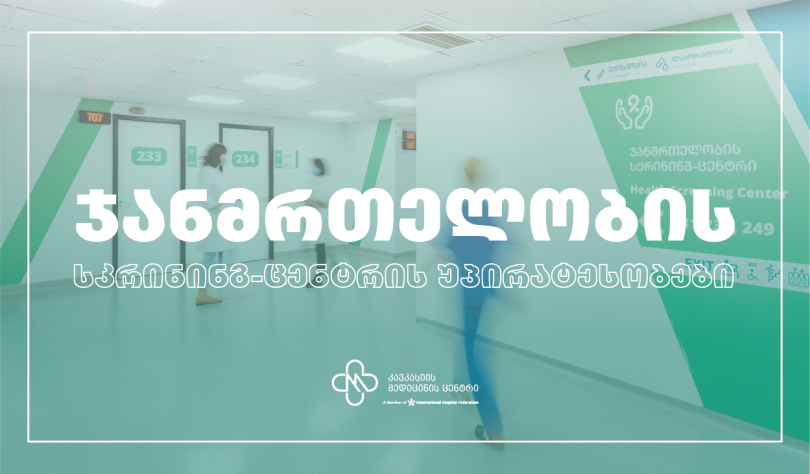


Blog
Ovarian Cyst Removal
22 January 2020

An ovarian cyst is a common gynecological disease that every woman may face. Experts say that about 80% of women all over the world at some point face the mentioned disease. This article discusses what ovarian cyst is and in what cases it should be removed.
Some varieties of cysts are not dangerous and resolve within a few months. While others are dangerous and can cause infertility or lead to cancer.
The most harmless are functional cysts, which resolve on their own. A dermoid cyst is also usually not dangerous. In rare cases, the neoplasm reaches a large size and puts pressure on other organs. Mucinous cysts are the most dangerous due to the tendency to malignancy.
Another complication is rupture of the cyst or bowel looping, which can cause the development of peritonitis, inflammation of the peritoneum. Ovarian cysts may lead to infertility.
An ultrasound scan allows finding out the details of the disease - to see the cyst and determine where it is located. Laparoscopy will help not only to visualize the tumor, but also to take material for biopsy. A biopsy will reveal the malignant or benign nature of the tumor.
In cases where cyst treatment requires surgical intervention, computed tomography and magnetic resonance imaging are carried out. Examinations provide more information about the cyst, its structure, size.
The Caucasus Medical Center offers patients the diagnosis of ovarian cysts. The hospital is located in Tbilisi but receives international residents as well. The gynecological department of the clinic employs highly qualified doctors who can quickly and painlessly diagnose and prescribe the necessary treatment. The center is equipped with the latest equipment, which allows getting reliable diagnostic examination results.
An ovarian cyst is removed surgically during the following cases:
Resection of the ovarian cyst is performed when it is necessary to maintain reproductive function. If an ovarian cyst is found in a patient during menopause, the operation may be more radical and include complete removal of the ovary.
Cyst removal may be carried out in several ways. The minimally invasive method is called laparoscopy, the autopsy of the abdominal cavity is called a laparotomy.
During laparoscopy, the surgeon makes several incisions on the patient’s stomach and inserts a laparoscope. The laparoscope is equipped with magnifying lenses and a camera image of which is transmitted to the monitor. The doctor removes a fragment of the ovary with a cystic formation or the whole ovary and removes the removed parts through an incision. The procedure lasts no more than an hour, surgery is performed under anesthesia.
Removal of the ovarian cyst is also carried out in the usual way - by the incision of the abdominal cavity. Laparoscopy, in contrast to laparotomy, allows minimizing injuries to tissues and blood vessels, reduce the recovery period and avoid possible complications after surgery.
The recovery period of patients after laparoscopic surgery takes several days. During the first days, patients suffer from pulling and sharp pains that pass over time. A few hours after surgery, patients can already independently move around the ward. Patients are prescribed a diet, sutures are treated, medical staff monitors the condition of the patient who underwent surgery. Patients are usually prescribed in less than a week. Sutures are removed after discharge.
Planning a pregnancy immediately after cyst removal surgery is not recommended. Sometimes patients are prescribed hormonal drugs immediately after surgery, in which case it is better to postpone pregnancy until the end of the course of treatment. If the operation was successful and the patient has no complications, pregnancy can be planned right after the first menstrual cycle.
Laparoscopic removal of the ovarian cyst requires the surgeon to be careful and professional. Laparoscopic surgery at the Caucasus Medical Center is carried out throughout 24 hours. Doctors of the medical center are the pride of the clinic, many of them have gained experience working abroad. The Department of Gynecology is led by a member of the Association of Gynecologists-Endoscopists of Russia and Europe, Doctor of Medical Sciences Vadim Khatiashvili.
Removing an ovarian cyst abroad is not at all difficult. All you need is to book an appointment with the doctor. The staff of the Caucasus Medical Center will take care of booking tickets and accommodation, and doctors will begin treatment immediately after the examination and clarification of the diagnosis.
The Caucasus Medical Center is a regional leader in healthcare. The clinic offers patients diagnostic and treatment services at affordable prices. Patients are supported at all stages of treatment, including after discharge from the hospital. You may read the reviews of patients who underwent treatment at the medical center on our website.
What is an ovarian cyst?
An ovarian cyst is a benign neoplasm filled with fluid, blood, or mucus. A cyst forms on the surface of the ovaries. The ovaries are paired female reproductive organs in which reproductive cells mature. They are also responsible for the production of sex hormones.Some varieties of cysts are not dangerous and resolve within a few months. While others are dangerous and can cause infertility or lead to cancer.
Why do ovarian cysts develop?
Ovarian cysts occur for various reasons. The main reasons include:- Hormonal imbalance;
- Early onset menstruation;
- Abortion;
- Inflammation and infection;
- Thyroid problems.
What are the symptoms of ovarian cysts?
The presence of cysts on the ovary may indicate:- Uterine bleeding, not associated with menstruation;
- Menstrual irregularities (in duration, intensity, and also delayed menstruation);
- Pulling or dull pain in the lower abdomen (can also occur during sexual intercourse and physical activity);
- Weakness, nausea;
- Breast engorgement (increase in size and pain of glands due to expansion and pressure exerted by the synthesis and storage of breast milk after childbirth);
- An increase in the size of the abdomen (during large cystic tumors);
- Increased body temperature to 38-39 C;
- Frequent urination;
- In some cases, weight gain;
- The tension of the anterior abdominal wall;
What are the types of ovarian cysts?
Several types of ovarian cysts are distinguished, depending on the structure of the cysts and the way of its formation.- A functional ovarian cyst is represented by a follicular cyst or corpus luteum cyst, which are formed from follicles or the corpus luteum;
- A dermoid cyst is a benign tumor, inside of which there may be cells and tissues of the body, for example, hair or cartilage;
- Endometrioid cyst occurs when uterine cells enter the ovaries;
- Cystadenoma, a rare type of cyst, a benign tumor that can become malignant;
- A mucinous cystadenoma containing mucus reaches a large size and can become malignant.
What can be complications?
Cysts are benign tumors and usually do not require treatment, because they go away on their own. In some cases, cysts remain in the ovary and can develop into malignant tumors.The most harmless are functional cysts, which resolve on their own. A dermoid cyst is also usually not dangerous. In rare cases, the neoplasm reaches a large size and puts pressure on other organs. Mucinous cysts are the most dangerous due to the tendency to malignancy.
Another complication is rupture of the cyst or bowel looping, which can cause the development of peritonitis, inflammation of the peritoneum. Ovarian cysts may lead to infertility.
Diagnosis of ovarian cysts
The diagnosis of ovarian cysts begins in the gynecologist’s room with a visual examination of the patient. The doctor can detect enlarged ovaries and prescribe a series of tests. In particular, a blood count will show the presence or absence of inflammation.An ultrasound scan allows finding out the details of the disease - to see the cyst and determine where it is located. Laparoscopy will help not only to visualize the tumor, but also to take material for biopsy. A biopsy will reveal the malignant or benign nature of the tumor.
In cases where cyst treatment requires surgical intervention, computed tomography and magnetic resonance imaging are carried out. Examinations provide more information about the cyst, its structure, size.
The Caucasus Medical Center offers patients the diagnosis of ovarian cysts. The hospital is located in Tbilisi but receives international residents as well. The gynecological department of the clinic employs highly qualified doctors who can quickly and painlessly diagnose and prescribe the necessary treatment. The center is equipped with the latest equipment, which allows getting reliable diagnostic examination results.
When to remove an ovarian cyst?
Surgical intervention is used when there is a threat of rupture of the cyst or torsion. The presence of pus inside the cyst is an indication for surgery.An ovarian cyst is removed surgically during the following cases:
- The cyst increases in size, does not resolve, and does not respond to drug treatment;
- There is a risk of conversion to a malignant tumor;
- The neoplasm is located inside the ovary;
- A benign neoplasm is a dermoid, mucinous, or endometriotic cyst.
Ovarian cyst removal surgeries
Removing the damaged area of the ovary along with the cyst is called resection. Complete removal of the ovary is called ovariectomy. If during the surgical procedure the ovary is removed along with the fallopian tube, this operation is called adnexectomy.Resection of the ovarian cyst is performed when it is necessary to maintain reproductive function. If an ovarian cyst is found in a patient during menopause, the operation may be more radical and include complete removal of the ovary.
Cyst removal may be carried out in several ways. The minimally invasive method is called laparoscopy, the autopsy of the abdominal cavity is called a laparotomy.
Laparoscopy of the ovarian cyst
Preparation for surgery includes a complete examination of the patient. What specific analysis needs to be done is decided by the attending physician. Typically, the examination includes a blood count, ultrasound, fluorography, determination of the Rhesus factor and blood group, test for detecting the presence of infections.During laparoscopy, the surgeon makes several incisions on the patient’s stomach and inserts a laparoscope. The laparoscope is equipped with magnifying lenses and a camera image of which is transmitted to the monitor. The doctor removes a fragment of the ovary with a cystic formation or the whole ovary and removes the removed parts through an incision. The procedure lasts no more than an hour, surgery is performed under anesthesia.
Removal of the ovarian cyst is also carried out in the usual way - by the incision of the abdominal cavity. Laparoscopy, in contrast to laparotomy, allows minimizing injuries to tissues and blood vessels, reduce the recovery period and avoid possible complications after surgery.
The recovery period of patients after laparoscopic surgery takes several days. During the first days, patients suffer from pulling and sharp pains that pass over time. A few hours after surgery, patients can already independently move around the ward. Patients are prescribed a diet, sutures are treated, medical staff monitors the condition of the patient who underwent surgery. Patients are usually prescribed in less than a week. Sutures are removed after discharge.
Planning a pregnancy immediately after cyst removal surgery is not recommended. Sometimes patients are prescribed hormonal drugs immediately after surgery, in which case it is better to postpone pregnancy until the end of the course of treatment. If the operation was successful and the patient has no complications, pregnancy can be planned right after the first menstrual cycle.
Laparoscopic removal of the ovarian cyst requires the surgeon to be careful and professional. Laparoscopic surgery at the Caucasus Medical Center is carried out throughout 24 hours. Doctors of the medical center are the pride of the clinic, many of them have gained experience working abroad. The Department of Gynecology is led by a member of the Association of Gynecologists-Endoscopists of Russia and Europe, Doctor of Medical Sciences Vadim Khatiashvili.
Removing an ovarian cyst abroad is not at all difficult. All you need is to book an appointment with the doctor. The staff of the Caucasus Medical Center will take care of booking tickets and accommodation, and doctors will begin treatment immediately after the examination and clarification of the diagnosis.
The Caucasus Medical Center is a regional leader in healthcare. The clinic offers patients diagnostic and treatment services at affordable prices. Patients are supported at all stages of treatment, including after discharge from the hospital. You may read the reviews of patients who underwent treatment at the medical center on our website.
Other Blogposts

Explore Now
სიცოცხლის რიტმი: რა უნდა ვიცოდეთ გულის არითმიის შესახებ?
18 July 2024
არითმია, ანუ არარეგულარული გულისცემა, გულის ნორმალური რიტმის ნებისმიერი ტიპის დარღვევას ეწოდება. ფიზიოლოგიურად გულისცემის სიხშირე შეიძლება გაიზარდოს ფიზიკური აქტივობის შესაბამისად ან შემცირდეს მოსვენებისა და ძილის დროს. ასევე, გულისცემის გამოტოვების იშვიათი შეგრძნება, უმეტესწილად არ უკავშირდება პათოლოგიურ ცვლილებებს, თუმცა, ხშირი არარეგულარული რითმი ძირითადად მიგვანიშნებს არითმიებზე, რა დროსაც გულისცემის პათოლოგიური ცვლილების გამო, ორგანოები ვერ მარაგდება საკმარისი რაოდენობის სისხლით.

Explore Now
ბავშვი ინსულტის დიაგნოზით: 13 წლის მოზარდის განკურნების ისტორია
05 October 2022
2022 წლის დადგომას ველოდით. ალექსანდრესთან ერთად ნაძვის ხის აწყობას ვგეგმავდით. მოულოდნელად, მისი ოთახიდან უცნაური ხმები შემომესმა. სასწრაფოდ შევაღე კარი და ვნახე სრულიად გაშეშებული ჩემი შვილი, რომელიც ერთ წერტილში იყურებოდა და უემოციოდ იჯდა. მან ჩვენი ყურადღების მიქცევა მხოლოდ ხელების ოდნავი მოძრაობით შეძლო.

Explore Now
Benefits of a screening center
15 November 2021
Caucasus Medical Center plays a huge role in the development of the screening center. Here, diagnostics are performed using modern high-tech devices and the error is minimized. Also, the screening center is distinguished by the team of multidisciplinary doctors. With their joint involvement, the treatment issues of the patients are discussed.



